7. October 2010
For my project I will focus on a target group of children in the age between five and around eight years. This is normally the time when they are in a stage between kindergarten and primary school. The special thing about this age-group is, that they are able to understand more complex subjects as well as being in the stage of active play. Active play means, that they explore their world, their own boundaries and limits through play. Introducing interactive objects to them could be very interesting because probably they can understand the hidden features of those objects and therefore integrate them in their play.
 As a first step and to get insights how children approach to objects and which kind of creative solutions they can come up with I've decided to use "analog prototypes". These objects were given to children first without describing the functions of the objects. The analog prototypes where created out of wood. Each of them is a box of 12x12x12 cm and includes different kinds of hidden or more obvious features. The features varied from auditive experiences to more haptical ones. In the following I will give a short overview of the objects I've created for the first test.
Overview of "Analog Prototypes"
As a first step and to get insights how children approach to objects and which kind of creative solutions they can come up with I've decided to use "analog prototypes". These objects were given to children first without describing the functions of the objects. The analog prototypes where created out of wood. Each of them is a box of 12x12x12 cm and includes different kinds of hidden or more obvious features. The features varied from auditive experiences to more haptical ones. In the following I will give a short overview of the objects I've created for the first test.
Overview of "Analog Prototypes"


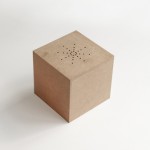
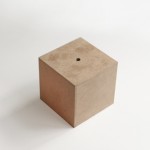
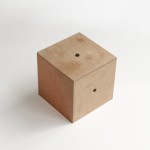
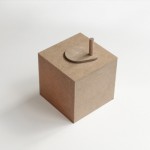
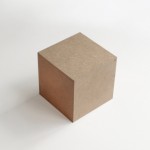

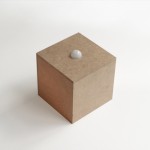 1. Squeezing
The "Squeeze cube" simply provided the opportunity to press rubber foam which was attached in the inside of the cube. The children immediately accepted this object and detected the possibilities. There was a great amount of ideas what to be done with this object (e.g. making music, use it as a sponge, etc). Mainly it was seen as a kind of input device to evoke reactions. From the visual appearance this object is very obvious and that was the reason for the quick detection of the functionality.
2. Hearing
This object was marked with a simple circular hole matrix - like the one you could find in loudspeakers. The children detected the object as being able to either make sound or even to speak inside - like a microphone. The object itself wasn't very interesting to the children, but the functionality was. They took for example the cover plate of the cube to attach it to other objects to transform them into sonic objects.
3. Looking
A hole in this cube should act as a attention attractor for the kids to look inside the cube - and they actually used this opportunity immediately. In the inside of the cube there was an iPod showing different pictures to the children. What was remarkable was that the children detected the iPod as being an iPod. This object was intended to have only playback functionality and because of the one hole, it was restricted to be viewed only by one kid at a time.
4. Looking Through
This object was at the outside appearance similar to the "Look cube", only that is has two holes - one at the top surface and another one at the side. Inside the cube is a mirror which was attached in 45° so that it was possible for the children to peek around the corner. This cube worked pretty good and it was amazing to see the children looking at the environment and even they used the cube collaboratively to look at each other.
5. Cranking
This Prototype was equipped with a wooden crank on the top surface. It was one of the objects, the children explored first and there was an immediate connection to a coffee grinder. Although the functionality is really banal, in the fantasy of the children it becomes a other object. This object was also declared as being a trigger for different kinds of reactions – e.g. play back music, let the cubes dance, etc.
6. Rattling
Basically this object is a rattle. Inside the cube there are rough pebbles which make sound, when the object is shaken. From the outside this functionality is hard to detect and that is the reason why the children tried this object as one of the last ones. The other objects were much more interesting for the kids because they were perceptible from the outside at first sight.
7. Feeling Movement
In the inside of this object there is a gyroscope connected to a battery. This gyro evokes a centrifugal force onto the cube which could be detected by holding the cube in hands. This functionality was also detected late by the children - because of the same reasons as the "Rattle cube" (it wasn't obvious on the outside). After discovering the possibility of this cube the children began to put things inside the cube (e.g. leaves, stones, earth) and looked how they began to spin because of the build in motor.
8. Detection
This object was the first one with a build in sensor (a IR module to detect presence), which was even visible at the outside. The form of the sensor is much like a bulb light and the children asked if this cube is able to make light. They were disappointed because it didn't produce light. Light could be a strong feedback for them - they used the cover plate in the same way as with the "Hear cube" equipping other cubes with the possibility to make light.
1. Squeezing
The "Squeeze cube" simply provided the opportunity to press rubber foam which was attached in the inside of the cube. The children immediately accepted this object and detected the possibilities. There was a great amount of ideas what to be done with this object (e.g. making music, use it as a sponge, etc). Mainly it was seen as a kind of input device to evoke reactions. From the visual appearance this object is very obvious and that was the reason for the quick detection of the functionality.
2. Hearing
This object was marked with a simple circular hole matrix - like the one you could find in loudspeakers. The children detected the object as being able to either make sound or even to speak inside - like a microphone. The object itself wasn't very interesting to the children, but the functionality was. They took for example the cover plate of the cube to attach it to other objects to transform them into sonic objects.
3. Looking
A hole in this cube should act as a attention attractor for the kids to look inside the cube - and they actually used this opportunity immediately. In the inside of the cube there was an iPod showing different pictures to the children. What was remarkable was that the children detected the iPod as being an iPod. This object was intended to have only playback functionality and because of the one hole, it was restricted to be viewed only by one kid at a time.
4. Looking Through
This object was at the outside appearance similar to the "Look cube", only that is has two holes - one at the top surface and another one at the side. Inside the cube is a mirror which was attached in 45° so that it was possible for the children to peek around the corner. This cube worked pretty good and it was amazing to see the children looking at the environment and even they used the cube collaboratively to look at each other.
5. Cranking
This Prototype was equipped with a wooden crank on the top surface. It was one of the objects, the children explored first and there was an immediate connection to a coffee grinder. Although the functionality is really banal, in the fantasy of the children it becomes a other object. This object was also declared as being a trigger for different kinds of reactions – e.g. play back music, let the cubes dance, etc.
6. Rattling
Basically this object is a rattle. Inside the cube there are rough pebbles which make sound, when the object is shaken. From the outside this functionality is hard to detect and that is the reason why the children tried this object as one of the last ones. The other objects were much more interesting for the kids because they were perceptible from the outside at first sight.
7. Feeling Movement
In the inside of this object there is a gyroscope connected to a battery. This gyro evokes a centrifugal force onto the cube which could be detected by holding the cube in hands. This functionality was also detected late by the children - because of the same reasons as the "Rattle cube" (it wasn't obvious on the outside). After discovering the possibility of this cube the children began to put things inside the cube (e.g. leaves, stones, earth) and looked how they began to spin because of the build in motor.
8. Detection
This object was the first one with a build in sensor (a IR module to detect presence), which was even visible at the outside. The form of the sensor is much like a bulb light and the children asked if this cube is able to make light. They were disappointed because it didn't produce light. Light could be a strong feedback for them - they used the cover plate in the same way as with the "Hear cube" equipping other cubes with the possibility to make light.